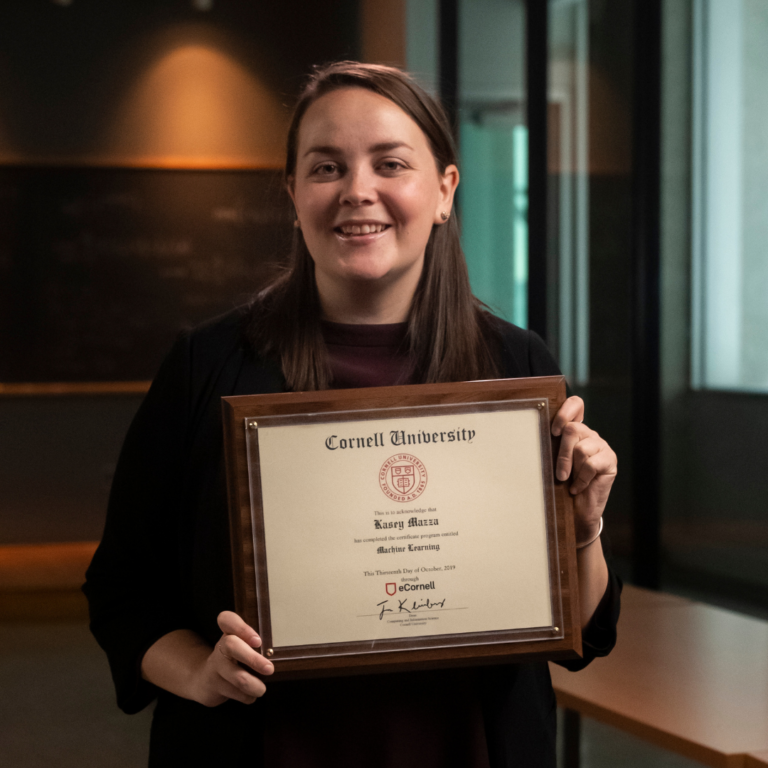Kyle Harms received his Ph.D. in Computer Science in 2017 at Washington University in St. Louis. Under the supervision of Dr. Caitlin L. Kelleher, he investigated leveraging completion problems to help enable middle school students to learn computer programming independently. He has completed and published research on a variety of topics relating to young learners and learning how to code, both through structured programs and through self-taught methods. His software work is available on the novice programming environment, Looking Glass, and the open source program github.

Web Design and DevelopmentCornell Certificate Program
Request More Info
Overview and Courses
This front-end web development certificate is all about designing and building websites that are focused on the needs of users, striking a balance between form and function. From the very beginning, you will explore the ideas of mental models and target audience personas. By taking a design-first, code-second approach, you will learn to structure content and make informed design decisions based on the needs of potential website visitors before writing a single line of code. Foundational concepts of writing valid HTML and CSS are paired with accessibility best practices to ensure you can implement your designs effectively and accurately. Through an introduction to JavaScript, jQuery, and data collection, you will explore adding simple interactivity and forms to your websites. Throughout these courses, you will practice meeting the needs of your target audiences while designing web experiences that are attractive, functional, and accessible.
The courses in this certificate program are required to be completed in the order that they appear.
Course list
- Nov 19, 2025
- Dec 31, 2025
- Feb 11, 2026
- Mar 25, 2026
- May 6, 2026
- Jun 17, 2026
- Jul 29, 2026
In this course, students will start by identifying the various types of elements that exist in a web page and the importance of information architecture. They will immediately begin organizing and structuring web page content and then markup the content using HTML. This process will introduce the document object model, which enables students to build a mental model of how web pages are built and how web browsers render those pages. Important facets of writing valid HTML that is also semantically sound are introduced through a number of code writing activities. From single page coding, we zoom out to explore how websites with multiple pages, hyperlinks, and navigation are organized and developed. Students will take these new skills and apply them to building a simple multi-page website with valid code and a functional navigation.
- Dec 3, 2025
- Jan 14, 2026
- Feb 25, 2026
- Apr 8, 2026
- May 20, 2026
- Jul 1, 2026
- Aug 12, 2026
In this course, students will engage in a design-first approach, focusing on understanding the needs of the user and prioritizing designing over coding. By engaging with personas and gaining empathy for a website's audience, students identify the needs of their users and apply visual design principles to make sites accessible. With designs in hand, students will learn to write Cascading Style Sheets (CSS) and create rules to implement their design. Along with writing and implementing CSS code, students will explore validating, troubleshooting, and improving their CSS using various techniques, including by leveraging generative AI.
- Dec 17, 2025
- Jan 28, 2026
- Mar 11, 2026
- Apr 22, 2026
- Jun 3, 2026
- Jul 15, 2026
- Aug 26, 2026
In this course, you will employ visual design practices and principles to create attractive, functional websites styled with CSS. Through a thorough investigation of the CSS box model, you are introduced to concepts such as padding, margin, whitespace, and element sizing. These concepts are then given the context of visual design principles to help you make layout and design choices that are user-centric and functional. You will then practice the layout design process to create sketches and wireframes of your designs. With plans in place, you will then write CSS to implement the design to effectively style and layout HTML elements accurately. Finally, you will go a step further to ensure this design is flexible and responsive on the many devices that could be used to visit your site.
- Nov 19, 2025
- Dec 31, 2025
- Feb 11, 2026
- Mar 25, 2026
- May 6, 2026
- Jun 17, 2026
- Jul 29, 2026
- Dec 3, 2025
- Jan 14, 2026
- Feb 25, 2026
- Apr 8, 2026
- May 20, 2026
- Jul 1, 2026
- Aug 12, 2026
In this course, you will build a form to collect data input. This process begins with analyzing how web requests work and identifying the parameters of the hypertext transfer protocol (HTTP). Next, you will design and code a form to collect user data. You'll use advanced topics such as client-side form validation and error messages to improve the user experience and overall validity of collected data. You will then evaluate your form and implementation to ensure the final design is appropriate and functional.
- Dec 17, 2025
- Jan 28, 2026
- Mar 11, 2026
- Apr 22, 2026
- Jun 3, 2026
- Jul 15, 2026
- Aug 26, 2026
Request more Info by completing the form below.
How It Works
- View slide #1
- View slide #2
- View slide #3
- View slide #4
- View slide #5
- View slide #6
- View slide #7
- View slide #8
- View slide #9
Faculty Author
Key Course Takeaways
- Establish a framework for success in front-end web development
- Produce valid HTML that organizes content in a meaningful way for your target audience
- Use CSS to design and implement a web page that is appropriate for your target audience
- Employ visual design principles to create attractive, functional websites styled and laid out with CSS
- Enhance the user experience through interactivity with JavaScript
- Recognize basic JavaScript & jQuery syntax rules and event-based programming techniques
- Design, code, and evaluate a form to collect data inputs from your target audience

Download a Brochure
Not ready to enroll but want to learn more? Download the certificate brochure to review program details.

What You'll Earn
- Web Design and Development Certificate from Cornell Ann S. Bowers College of Computing and Information Science
- 60 Professional Development Hours (6 CEUs)
Watch the Video
Who Should Enroll
- Aspiring web developers, web designers, and UX designers
- Backend programmers who need front-end skills to become full-stack developers
- Self-taught web programmers
- Entrepreneurs
Explore Related Programs
Request Information Now by completing the form below.

Web Design and Development
| Select Payment Method | Cost |
|---|---|
| $3,750 | |






































